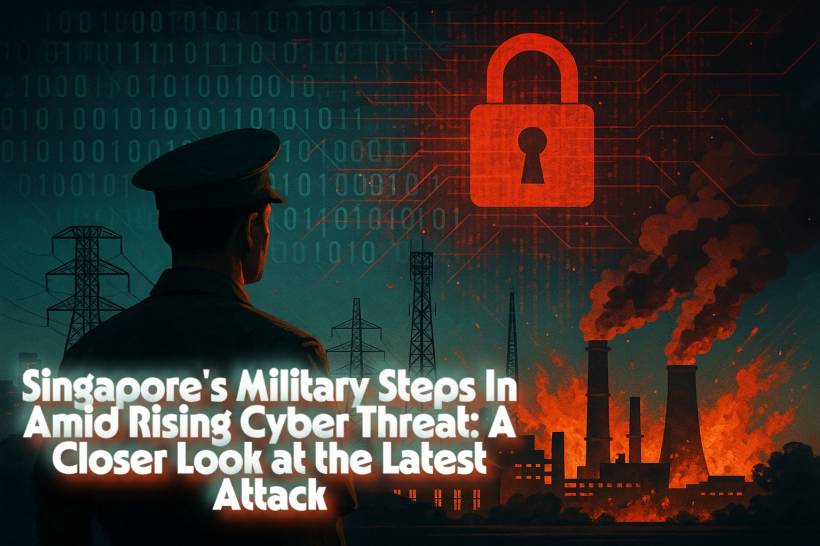In an increasingly digital world, even a nation as tech-savvy as Singapore is not immune to cyber threats. On July 19, Singapore's Defence Minister Chan Chun Sing revealed that select military units have been deployed to assist in combating an ongoing cyberattack targeting the country's critical infrastructure. The revelation underscores the growing complexity of modern threats and the importance of a unified national response.
Cybersecurity Meets National Defence
Traditionally, cyberattacks were seen as issues for IT departments and cybersecurity agencies. But the recent incident in Singapore reflects a shifting landscape—where digital intrusions are now being treated with the same seriousness as physical attacks. Minister Chan confirmed that these military units are working in tandem with the Cyber Security Agency (CSA) to fortify national defences.
He described this cyberattack as an example of the "emerging threats" the military must now prepare for—indicating a broader mandate for national defence forces in the digital era.
The Threat: Advanced Persistent Threats (APT) in Action
So, what exactly are we up against? Coordinating Minister for National Security K. Shanmugam, who also serves as Minister for Home Affairs, described the incident as an Advanced Persistent Threat (APT)—a sophisticated cyberattack where the intruders gain unauthorized access and remain undetected for extended periods.
He further revealed that the group behind the attack has been identified as UNC3886, a name familiar to cybersecurity experts. According to Mandiant, a Google-owned security firm, UNC3886 is linked to a highly skilled, China-nexus cyber espionage group. However, Shanmugam refrained from directly naming the group's sponsors or confirming its ties to any state.
What's at Stake?
Though no successful breach has been confirmed, the potential implications are serious. A cyberattack on Singapore's critical systems—think power grids, water systems, hospitals, or financial institutions—could paralyze the nation.
"If it succeeds," said Shanmugam, "it can conduct espionage and it can cause major disruption to Singapore and Singaporeans." A successful attack on the power system alone could lead to blackouts that disrupt hospitals, transport, and even the nation's economy.
The minister painted a stark picture: if core infrastructure is compromised, banks, airports, and key industries could grind to a halt. And that's not just an inconvenience—it could be a national crisis.
The Rise in Cyber Incidents
Unfortunately, this isn't an isolated event. Between 2021 and 2024, Singapore experienced a more than fourfold increase in suspected APT-related incidents. One of the most high-profile breaches occurred in 2018, when attackers accessed medication records of about 160,000 patients—including then-Prime Minister Lee Hsien Loong.
The upward trend shows that Singapore's digital defences are under increasing pressure, and adversaries are evolving rapidly.
China Responds to Allegations
In response to the finger-pointing, China's embassy in Singapore issued a statement on Saturday expressing "strong dissatisfaction" with media reports linking the UNC3886 group to China.
The embassy emphasized that "China is one of the main victims of cyberattacks," and reiterated that the nation does not support, condone, or participate in any hacking activities. China's position: accusations like these are baseless and politically motivated.
When pressed by reporters on Saturday, Shanmugam maintained a measured tone, saying, "As far as the Singapore government is concerned, we can say we are confident that it is this particular organisation. Who they are linked to, and how they operate, is not something I want to go into."
Why This Transparency Matters
Singapore's Minister for Communications and Information, Josephine Teo, took to Facebook to explain why the government publicly named the threat actor. "It's important for Singaporeans to know where the attack is coming from and what the potential consequences will be," she wrote.
Transparency in such situations isn't just about accountability—it helps build public awareness, bolsters trust in government responses, and emphasizes the seriousness of cybersecurity.
A Battle Against Stealthy Enemies
Commenting on the incident, Satnam Narang, a senior researcher at US-based cybersecurity firm Tenable, summed up the challenge: "Combating such stealthy opponents is becoming increasingly demanding as the scale and complexity of IT infrastructure that organisations and nations must defend continues to grow."
Indeed, as technology advances, so do the tools and techniques of cyber adversaries. Governments are finding themselves in a constant game of catch-up—balancing innovation, security, and resilience.
Final Thoughts
This latest attack may have failed—so far—but it offers a stark reminder: cyber warfare is real, and Singapore is treating it like any other threat to national security. As APT groups grow more brazen and skilled, the lines between military defence and cybersecurity are blurring fast. For a digitally advanced country like Singapore, staying one step ahead might just be the key to staying safe.




